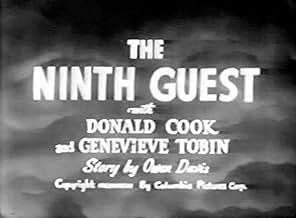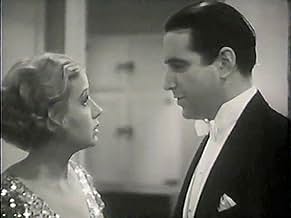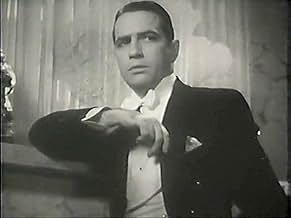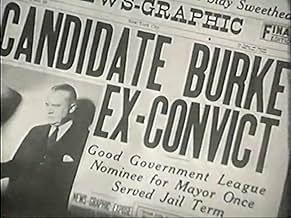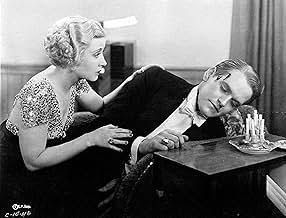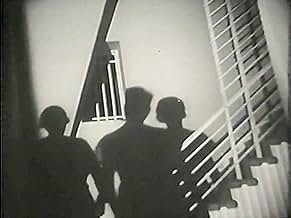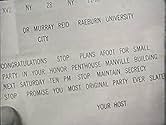Eight people are invited to dinner in a fashionable penthouse apartment. After they are wined and dined, a voice on the radio informs them that they will be murdered unless they manage to ou... Read allEight people are invited to dinner in a fashionable penthouse apartment. After they are wined and dined, a voice on the radio informs them that they will be murdered unless they manage to outwit the ninth guest: Death.Eight people are invited to dinner in a fashionable penthouse apartment. After they are wined and dined, a voice on the radio informs them that they will be murdered unless they manage to outwit the ninth guest: Death.
Vince Barnett
- William Jones
- (as Vincent Barnett)
Samuel S. Hinds
- Dr. Murray Reid
- (as Samuel Hinds)
Sidney Bracey
- Hawkins, the Butler
- (as Sidney Bracy)
Mildred Gover
- Jean's Maid
- (uncredited)
Arthur Hoyt
- Osgood's Secretary
- (uncredited)
Mary MacLaren
- First Telegraph Office Worker
- (uncredited)
Billie Seward
- Office Worker
- (uncredited)
Gayne Whitman
- Voice of the host
- (uncredited)
Charles C. Wilson
- Burke
- (uncredited)
Featured reviews
This is a very tough-to-find classic studio horror film from the golden age of horror films. Above all, it deserves to be seen by more fans of the films of that era. While it is very obvious from the beginning as to who the killer is (fans of this type of film will know based on formula), the film is consistently entertaining and very well-directed. Unlike many slow and stagy productions from the early 30s, this one is very fluid and Roy William Neill, who would later direct many of the Rathbone Sherlock Holmes films, has an excellent grasp on how to effectively move his camera. It is refreshingly unpretentious and almost sickly stylish at times and not stagy as a Monogram and Mascot feature almost inherently at some level must be. It is Grand Guignol fun with a stylish Art-Deco apartment where eight guests are trapped by the titular "ninth guest", a voice from the radio that commands their ill-fated party. It is reminiscent of Ulmer's 'The Black Cat' from the same year, in how it uses a modern design to decorate its' house of horror. The cast is very good and includes Donald Cook, who next year made a fine Ellery Queen and Edwin Maxwell and Samuel S. Hinds lend their usual solid performances for this type of film. It was made by Colombia Pictures.
I'm not sure how or why I haven't seen this one before. The 9th Guest is an incredibly enjoyable discovery on my part. As any number of comments online will point out, the movie plays out much like Agatha Christie's better known And Then There Were None. Though The 9th Guest isn't a comedy, I'd be shocked to discover that this film wasn't at least a partial inspiration behind the wickedly funny Murder by Death and/or Clue.
In the film, eight guests have been invited to a mysterious party where they are promised a memorable evening. Each guest has a closet full of skeletons and most are quite vocal in their feelings toward the other members of the party. We later learn that the titular 9th guest is "Death". The party's host makes his presence known via a radio in the main room. He promises that throughout the night, one-by-one, each member of the party will be killed. With no means of escape, who will survive the night?
The acting in The 9th Guest is first rate. I'm not sure I was overly familiar with most of the cast, but all are outstanding. The writing is also worth noting. The dialogue is especially sharp. But I think the biggest kudos for the success of The 9th Guest have to go to director Roy William Neill (oddly credited as R. William Neill). It takes a masterful hand to wring this much atmosphere out of a film. Add to that the fact Neill does this without the usual gothic trappings I generally consider necessary to an atmospheric film. Instead of an old, dark Victorian mansion or some ancient, crumbling gothic abbey, The 9th Guest features a thoroughly modern (for its time) art deco penthouse setting I wouldn't normally associate with a film like this. The movie is only let down by how ridiculous some of the characters act when faced with death. Had they just kept a level head, more might have survived. But how fun would that have been?
8/10
In the film, eight guests have been invited to a mysterious party where they are promised a memorable evening. Each guest has a closet full of skeletons and most are quite vocal in their feelings toward the other members of the party. We later learn that the titular 9th guest is "Death". The party's host makes his presence known via a radio in the main room. He promises that throughout the night, one-by-one, each member of the party will be killed. With no means of escape, who will survive the night?
The acting in The 9th Guest is first rate. I'm not sure I was overly familiar with most of the cast, but all are outstanding. The writing is also worth noting. The dialogue is especially sharp. But I think the biggest kudos for the success of The 9th Guest have to go to director Roy William Neill (oddly credited as R. William Neill). It takes a masterful hand to wring this much atmosphere out of a film. Add to that the fact Neill does this without the usual gothic trappings I generally consider necessary to an atmospheric film. Instead of an old, dark Victorian mansion or some ancient, crumbling gothic abbey, The 9th Guest features a thoroughly modern (for its time) art deco penthouse setting I wouldn't normally associate with a film like this. The movie is only let down by how ridiculous some of the characters act when faced with death. Had they just kept a level head, more might have survived. But how fun would that have been?
8/10
"The Ninth Guest" was produced as a motion picture by Columbia, this in 1933 and released in 1934. In the Fifties, it was released to TV by Screen Gems, a subsidiary of Columbia, but was subsequently pulled from circulation. I was told some time ago, by someone at Columbia, that the picture was being readied for a rerelease - hopefully with the title card restored to the original - but this has not yet happened.
The film was based on the 1930 book entitled "The Invisible Host" and also the stage version, also 1930, with the title "The Ninth Guest" - this guest being Death! The book's novel plot has eight people invited and trapped in a penthouse, where they are scheduled to die sequentially (in the film, a fancy illuminated wall clock steadfastly renders the time, as if emphasizing the inevitable deaths!). One of thirty such books published in the early Thirties by the Mystery League, the most commercial aspect of these their striking art deco dust jackets - the main reason people collect them nowadays (most of the entries being outlandishly mediocre!).
The motion picture was helmed by veteran director, Roy William Neill, probably best remembered for directing eleven of the twelve superb "Sherlock Holmes" features released by Universal in the Forties. With the 1934 mystery, Neill transcended the finite area of a penthouse, in which most of the narrative transpires, with creative lighting and fluid camerawork - in one scene, the frightened victims are photographed through a large statuary hand, appearing to be in its grasp; for another, the cowering group are viewed from within a radio, the slats symbolizing bars! These creative touches are not heavy-handed but rather executed quickly; to look away could be to miss either! Discovering eight coffins lining the roof garden is yet another macabre touch.
Often compared to Agatha Christie's 1939 masterpiece, "And Then There Were None", "The Ninth Guest" gets into a bind when only three survivors remain in the penthouse, one of whom has to be the killer - whereas Christie's novel employs an ingenious gimmick serving to conceal the villain's identity, and in the end, all ten of the characters are dead (this not suitable to Christie's theatrical version, "Ten Little Indians", she changed it so as to have two people survive the mass murder!).
The Roy William Neill tour de force makes up for not having the guilty party consume poison, as in the novel and play, by electrocuting himself before the startled eyes of the couple who survived his machinations. As sparks fly about wildly and the current hums, the camera goes from the quivering killer to a light up in the wall, fluttering crazily before it goes out. End of picture.
An old Screen Gems print of "The Ninth Guest" can be viewed on the Internet. It's worth seeing!
The film was based on the 1930 book entitled "The Invisible Host" and also the stage version, also 1930, with the title "The Ninth Guest" - this guest being Death! The book's novel plot has eight people invited and trapped in a penthouse, where they are scheduled to die sequentially (in the film, a fancy illuminated wall clock steadfastly renders the time, as if emphasizing the inevitable deaths!). One of thirty such books published in the early Thirties by the Mystery League, the most commercial aspect of these their striking art deco dust jackets - the main reason people collect them nowadays (most of the entries being outlandishly mediocre!).
The motion picture was helmed by veteran director, Roy William Neill, probably best remembered for directing eleven of the twelve superb "Sherlock Holmes" features released by Universal in the Forties. With the 1934 mystery, Neill transcended the finite area of a penthouse, in which most of the narrative transpires, with creative lighting and fluid camerawork - in one scene, the frightened victims are photographed through a large statuary hand, appearing to be in its grasp; for another, the cowering group are viewed from within a radio, the slats symbolizing bars! These creative touches are not heavy-handed but rather executed quickly; to look away could be to miss either! Discovering eight coffins lining the roof garden is yet another macabre touch.
Often compared to Agatha Christie's 1939 masterpiece, "And Then There Were None", "The Ninth Guest" gets into a bind when only three survivors remain in the penthouse, one of whom has to be the killer - whereas Christie's novel employs an ingenious gimmick serving to conceal the villain's identity, and in the end, all ten of the characters are dead (this not suitable to Christie's theatrical version, "Ten Little Indians", she changed it so as to have two people survive the mass murder!).
The Roy William Neill tour de force makes up for not having the guilty party consume poison, as in the novel and play, by electrocuting himself before the startled eyes of the couple who survived his machinations. As sparks fly about wildly and the current hums, the camera goes from the quivering killer to a light up in the wall, fluttering crazily before it goes out. End of picture.
An old Screen Gems print of "The Ninth Guest" can be viewed on the Internet. It's worth seeing!
- Ray Cabana, Jr.
It's almost certain that Agatha Christie did not see this 1932 movie which will inevitably remind the viewer of her classic murder mystery "and then there were none ": the unknown person who throws a party and invites people who have something to be guilty about; the similarities in the first part are striking : the host is not present ,there' s a voice out of a radio accusing the guests ,they cannot leave the penthouse (the doors are charged with electricity ) ,and of course,they begin to suspect each other.And let the countdown begin!
In fact , apart from the confessions , the development is closer to modern thrillers such as " saw" or the Spanish thriller "la habitacion de Fermat" .
The atmosphere itself is charged with electricity ;the only sound is the unbearable ticking of a clock ; the problem is that there is too little time to make acquaintance with the characters and the final confession is too hurried for comfort: if you have not read the book (very hard to find nowadays) ,it's sometimes difficult to follow the plot -the film hardly lasts 70 minutes.And it lacks the implacable mastery of Dame Christie .
Yet, her buffs should watch this because it contains the seeds of her 1939 masterful thriller.
In fact , apart from the confessions , the development is closer to modern thrillers such as " saw" or the Spanish thriller "la habitacion de Fermat" .
The atmosphere itself is charged with electricity ;the only sound is the unbearable ticking of a clock ; the problem is that there is too little time to make acquaintance with the characters and the final confession is too hurried for comfort: if you have not read the book (very hard to find nowadays) ,it's sometimes difficult to follow the plot -the film hardly lasts 70 minutes.And it lacks the implacable mastery of Dame Christie .
Yet, her buffs should watch this because it contains the seeds of her 1939 masterful thriller.
A group of folks arrive at a mansion for a party. Each has received an unsigned invitation and are expecting an exciting night...and boy are they in for a surprise! It turns out some maniac has worked incredibly hard to create the setting and plans on killing off the guests...one by one. The guy communicates to everyone using a record player and no one is sure who the unknown host is...or if, perhaps, he's among the guests. Regardless, folks begin dying in the most diabolical manner...including poisonings and electrocutions! All, according to the machine, because these people are evil and deserve to be punished!
While the cast are mostly unknown actors and it's a B-movie from Columbia, don't think that it's just another schlocky B-film. No, instead it's very intelligently written and exciting...more so than many of the A-pictures. Well worth your time and amazingly good.
While the cast are mostly unknown actors and it's a B-movie from Columbia, don't think that it's just another schlocky B-film. No, instead it's very intelligently written and exciting...more so than many of the A-pictures. Well worth your time and amazingly good.
Did you know
- TriviaThe film's source material, "The Invisible Host", was a novel by the husband and wife team of Gwen Bristow and Bruce Manning. Their whodunit was inspired by a neighbor whose raucous radio disturbed them day and night. The novel begins: "That makes thirty-seven words, said the girl. Will you read the telegram again? came the voice over the wire. She read: Congratulations stop plans afoot for small surprise party in your honor Bienville penthouse next Saturday eight o'clock stop all sub rose big surprise stop maintain secrecy stop promise you most original party ever staged in New Orleans Signed Your host." The stage version, "The Ninth Guest", was written by Owen Davis. The Broadway production opened at the Eltinge 42nd Street Theatre in New York on August 25, 1930, and ran for 72 performances. The opening night cast included Berton Churchill, William Courtleigh, Alan Dinehart Grace Kern, Frank Shannon, and Robert Vivian.
- GoofsWhen the guests tie up the butler and the cook, no effort is made to locate Jones, the assistant butler. When Jones reappears, no real attempt is made to interrogate him.
- Quotes
First Telegraph Office Worker: [opening line] I'm sorry, sir, but you can't send any swear-words in a telegram!
- ConnectionsReferenced in Celui qui avait tué... la mort (1939)
- SoundtracksThe Gospel Train is Coming
(uncredited)
Traditional
Sung by Jean's maid.
- How long is The 9th Guest?Powered by Alexa
Details
- Release date
- Country of origin
- Language
- Also known as
- The Ninth Guest
- Production company
- See more company credits at IMDbPro
- Runtime
- 1h 5m(65 min)
- Color
- Aspect ratio
- 1.37 : 1
Contribute to this page
Suggest an edit or add missing content

